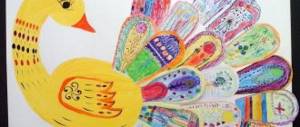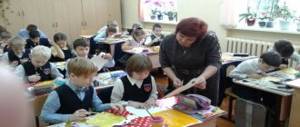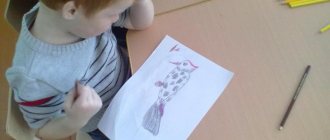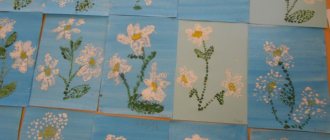How to draw wheat, ears, step by step?
Drawing ears of wheat is not difficult if you have auxiliary instructions in pictures that will clearly show you the whole drawing process. Even a child can draw wheat using it. I will draw wheat like this:
Let's first draw as many stalks as you need, there can be many of them, or maybe just one, then we begin to draw the spikelets from the bottom up:
Moreover, the top should be narrower than the bottom
Thus we draw each stem:
Now we draw small shoots around the spikelets:
Let's add some leaves:
Add a background if desired:
You can color it if necessary.
Let's draw a few ears of wheat, for this we take pencils and paper. Drawing wheat will be done in stages, so let’s highlight the following:
The first stage. On it we will depict the preparation of wheat ears. The pattern will be very similar in appearance to reeds.
Second phase. We add round shapes to our drawing, so that in appearance they look like a willow.
Third stage. We are working on more precise shapes of wheat ears. Let's also add elements such as tendrils to the ears.
Fourth stage. Is the final one in our drawing. To make the drawing closer to the real thing, add shading. And we draw even larger antennae on the ears of wheat.
There are several ways to draw wheat. These can be either complex images (with each grain drawn) or simple ones.
It all depends on your skill. For example, I have never drawn wheat, so I would use a simple option to start with). For example, like this:
- We work on a sheet of paper with a simple pencil and use an eraser if necessary.
- We make a light, barely noticeable sketch - we draw thin straight, slightly curved lines.
- then at the top of the lines we draw the wheat itself. We need to depict grains. Before we start drawing them, let’s remember how we depicted leaves in childhood. Remember)? These are the pointed elements that we draw. You can make ears from more rounded grains.
- Now, to make the spikelet more realistic, let's draw a very thin line on each side of the spikelet.
- draw “antennae” with thin stripes.
All. Our drawing is ready. We remove the extra lines and can draw a few more spikelets if the drawing requires it. And then you can color the wheat. For this you can use yellow and brown paint. But you can only work with a pencil.
Progress of the lesson:
Greeting game “Our smart heads”
Our smart heads will think a lot, cleverly. The ears will listen, the mouth will speak clearly. Hands will clap, Feet will stomp. Our backs straighten, we smile at each other.
Today we will meet with a fairy tale.
Demonstration of the tabletop theater "Spikelet"
Once upon a time there were two mice, Twirl and Twirl, and a cockerel, Vociferous Neck. The little mice only knew how to sing and dance, spin and twirl. The cockerel got up early in the morning, first woke everyone up with a song, and then got to work. One day a cockerel was sweeping the yard and saw a spike of wheat on the ground. The cockerel called the mice: “Twist and Twist, look what I found!” The little mice came running and said: “We need to thresh it.” -Who will thresh? - asked the cockerel. - Not me! - Krut squeaked. - Not me! - Vert squeaked. “Okay,” said the cockerel, “I’ll thresh it.” And he got to work. Meanwhile, the little mice started playing rounders. The cockerel finished threshing and shouted: “Hey, Cool, hey, Turn, look how much grain I threshed!” The little mice came running and squealed in one voice: “Now we need to carry the grain to the mill and grind the flour.” - Who will bear it? - asked the cockerel. - Not me! - Krut answered. - Not me! - Vert answered. “Okay,” said the cockerel, “I’ll take the grain to the mill.” He put the bag on his shoulders and went. And the little mice started a game of leapfrog. They jump over each other and have fun. The cockerel returned from the mill and called the little mice: “Here, Spin, here, Spin!” I brought flour. The little mice came running, looked, and couldn’t be happier: “Oh, the cockerel!” Well done! Now you need to knead the dough and bake the bread. - Who will knead? - asked the cockerel. And the little mice said again: “Not me!” - Krut squeaked. - Not me! - Vert squeaked. The cockerel thought and thought and said: “Apparently I’ll have to.” The cockerel kneaded the dough, hauled in the wood, and lit the stove. When the oven burned out, I planted bread in it. The little mice don’t waste any time either: they dance and sing songs. The bread was baked, the cockerel took it out, put it on the table, and the little mice were right there. And there was no need to call them. - Oh, I'm hungry! - Krut squeaked. - Oh, how hungry I am! - Vert squeaked. Hurry up and sit down at the table. And the cockerel says to them: “Wait, wait!” First tell me who found the spikelet? - You found! - the little mice screamed loudly. - Who threshed the spikelet? - the cockerel asked again. - You threshed! - they both said more quietly. -Who carried the grain to the mill? “You too,” Krut and Vert answered very quietly. - Who kneaded the dough? Did you carry firewood? He lit the stove, who baked the bread? - All of you. “All of you,” the little mice squeaked barely audibly. - What did you do? I don’t know what to say little mice. Twirl and Twirl began to crawl out from behind the table, but the cockerel could not hold them back. There is no reason to treat such lazy people with bread!
Didactic game “Put the fairy tale on the picture”
Find in the picture a place for a hut, for a cockerel and mice. Place the spikelet under the tree.
Didactic game “Hide the mouse from the fox”
The little mice decided to improve - to make a pie themselves and treat the cockerel. One mouse kneaded the dough, and the other went into the forest to pick mushrooms for the pie.
A mouse came to the forest and saw mushrooms. Do you see mushrooms in the picture? Where are they? Under the tree. How many mushrooms are there under the tree? Two mushrooms. But the mouse was unlucky; he just wanted to pick mushrooms and caught the eye of the fox. Rather, choose a leaf of a suitable size to hide the mouse from the fox.
Didactic game “Fold the spikelet”
What geometric shapes will we use to make a spikelet? From ovals. How many spikelets do you have in the picture? One spikelet. How many oval grains are needed for one spikelet? A lot of. Place ovals on the picture. Now use counting sticks to make the antennae of the spikelet.
Drawing "Spikelet"
Draw the antennae of the spikelet with a yellow pencil. Leave your fingerprints in place of the grains in the spikelet.
Modeling "Spikelet"
Roll out a sausage from yellow plasticine straight out and attach it to the cardboard, lightly pressing it on top with your palm. Place a toothpick stick on top of the sausage-spikelet (lengthwise) and press. Now take the wheat grains and press them on both sides of the stick.
Didactic game “What is missing”
A spikelet, a bun, and dough are laid out in front of the children. Cover yourself with a scarf. One item is hidden. Then the scarf is removed and the children are asked to say which object is missing.
Musical-dynamic pause “Top-top”
Children repeat the movements to the music as shown by the teacher.
Game with clothespins "Spikelet"
Make antennae out of clothespins for the spikelets.
Button game "Pie"
Arrange the buttons into circles of the appropriate color and size.
Visual activity “Pies and buns”
Place pie and rolls on trays. Choose a tray that fits the shape. Sprinkle the round bun with poppy seeds (previously coated with glue), and the oval bun with sesame seeds. But let’s make a pie with cherries - stick circles of cherries out of red plasticine onto the pie.
Didactic game "Tea set"
Select a cup and spoon for each saucer and place them on napkins of a suitable color.
Drawing with paints “Stalks of spikelets”
Draw the stems of the spikelets with a brush.
Exercise “Sifting flour through a sieve”
Children are asked to spoon the flour into a sieve and sift the flour over a tray.
Modeling from salt dough “Pie”
Children make a ball out of salted dough, flatten it into a flat cake, roll it into thin sausages and place it in a net on the pie. Peas are pressed into the free spaces.
Didactic exercise “What first, what then”
First the cockerel found a spikelet, show the spikelets. Then he took the grains out of the spikelet. Show the grains. Made flour from grains. Show me the flour. Made dough from flour. Show me the dough. Made a pie from the dough. But I'll show you the pie. And I suggest you try it.
There is a pie tasting.
This lesson is dedicated to all nerds and gluttons. You will see how to draw wheat with a pencil step by step. Naturally, I’m not going to draw the whole thing, but I’ll show you a few spikelets:
Wheat is an edible grass. Many goodies are made from it: bread, pasta, sweets, beer and other noble drinks. So both adults and children love her. True, no one likes to grow, grind, and process, but that’s a completely different conversation. In order to depict a spike of wheat, you need a lot of patience and care. There is no special image technique here, especially since there is no need to maintain proportions. There are so many types and varieties of wheat that she herself doesn’t even know which one she will grow. On the other hand, it needs to be done beautifully, repeat after me.
Abstract of OOD on drawing in the senior group “Spikelet”
Advanced training course for 340 rubles!
Emotional burnout of teachers. Prevention and ways to overcome
Municipal preschool educational institution
kindergarten No. 3 "Dolphin" general developmental type
Summary of organized educational activities
in drawing in the senior group "Spikelet".
Prepared and carried out
Target:
expand children's knowledge about the spikelet, teach how to draw a spikelet with gouache paint, conveying the features of its structure, consolidate drawing skills by dipping the bristles of a brush, cultivate artistic taste, and cultivate a desire to help others. Foster a caring attitude towards bread and the work of the people who make the bread.
Third way
If you want to know how to draw wheat a little more realistically, then this method is for you.
- Using a hard pencil, draw the stems with slightly bent lines and elongated ovals on top of them. At this stage, future spikelets resemble reeds. When sketching, do not press hard on the pencil; the lines should be faintly visible.
- Next, inside the ovals we draw grains that look like drops. First, draw one grain slightly at an angle, on the other side a little higher than the second, the third again slightly higher, opposite the second, and so on until you fill the previously drawn oval. It's okay if you go a little beyond the boundaries of the sketch.
- At the tips of the grains, draw awns with straight lines.
- Now we add volume to the stems by drawing an additional line next to the existing one.
- Draw leaves near the stems and erase the extra lines. To depict a folded piece of paper, draw an elongated triangle with the base facing up and another equally thin triangle at an angle.
- Draw a drawing with a soft pencil and add a little shadow at the base of each grain. Lightly color the stem and leaves on top and bottom with a hard pencil. You can use a pencil of the same hardness and press it with different pressures to get different shades. You can also color the resulting picture.
In this way, you can draw either one spikelet, or a whole sheaf, or even a field. In addition, the spikelets can be slightly modified by placing, for example, the grains at a slightly greater distance from each other, or by drawing an additional row of grains on the side.





